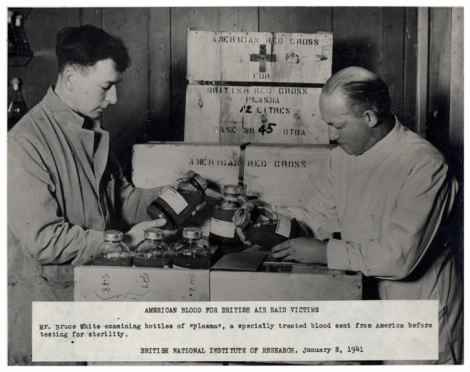 06-03-2018, 10:28 PM
06-03-2018, 10:28 PM
|
#2
|
|
I love it when a plan comes together.
Join Date: Oct 2009
Posts: 9,793
|
They may have been working with blood plasma which can nowadays be dried and reconstituted.
Quote:
Dr. Charles Richard Drew broke barriers in a racially divided America to become one of the most important scientists of the 20th century. His pioneering research and systematic developments in the use and preservation of blood plasma during World War II not only saved thousands of lives, but innovated the nation’s blood banking process and standardized procedures for long-term blood preservation and storage techniques adapted by the American Red Cross. ...
... Drew’s doctoral research assessed previous blood and transfusion research, blood chemistry and fluid replacement, and evaluated variables affecting shelf-life of stored blood — from types and amounts of anticoagulants (substances that prevent blood from clotting) and preservatives, to shapes of storage containers and temperature.
His key findings, complex procedures, and standards for collecting, processing and storing blood proved his expertise and led to an appointment to head the Blood for Britain Project (BFB), an effort to transport desperately needed blood and plasma to Great Britain, which was under attack by Germany.
What is plasma?
Plasma is a clear, yellow liquid containing various proteins and electrolytes that carries blood cells and other substances through the body. It can be used as a blood substitute to help replace fluids and treat shock. There is an advantage to using plasma over whole blood in emergency situations because it:
●keeps longer without refrigeration
●won't deteriorate when agitated during transport
●can be used with any blood type
●is much less likely to transmit diseases
●can be injected through veins, muscles, the skin, and in large doses
Drew worked with Scudder and E. H. L. Corwin to plan the organizational process of safely collecting, processing and storing large amounts of contamination-free plasma along with procedures for extracting plasma and ensuring safe arrival in Britain.
To separate plasma from blood cells, the team used centrifuging (separation of blood components by density) and sedimentation (separation of particles from a liquid). The plasma was then pooled from a collection of eight bottles using an anti-contamination technique under strict air and ultraviolet lighting conditions, and samples were cultured for bacteria. An anti-bacterial called Merthiolate was added to the blood product and batches were tested weekly. Finally, each batch was transferred to a shipping container and diluted with sterile saline solution. A final sample for bacteria-testing was taken before the containers were sealed and packed. By early August, a trial shipment of plasma was sent to England and confirmed "entirely satisfactory."

Britons examine bottles of plasma donated through the Blood for Britain Project during the Blood for Britain Project headed by Charles Drew during World War II.
|
Say, that guy on the left looks familiar.
|

|

|